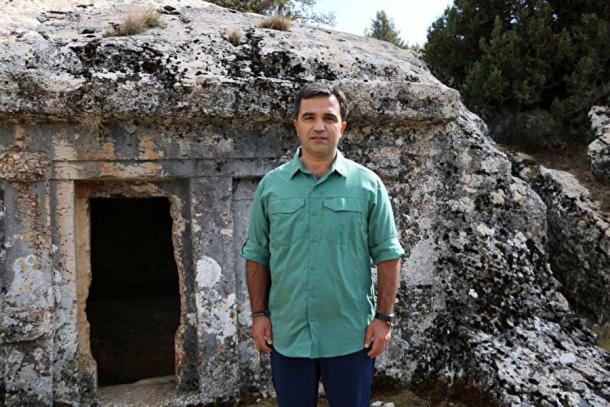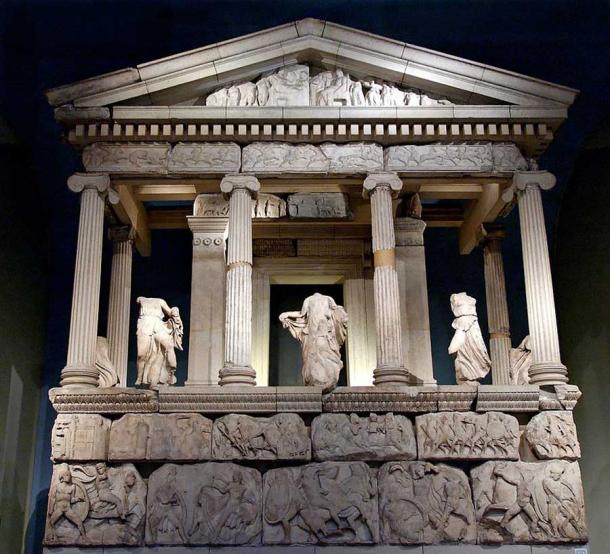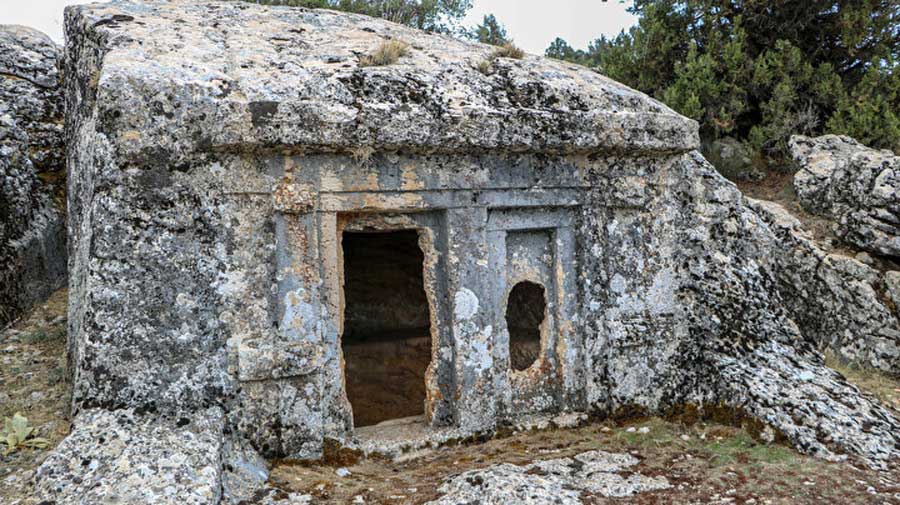Looters Blast Open 2500-year-old Lycian Rock-cut Tombs in Turkey
Hoping, perhaps, to lay their hands on something comparable to the famed Elmali Treasures, looters used explosives to break through the entrance of a 2,500-year-old Lycian rock-cut tomb in the Elmali district of Antalya province on Turkey’s southern Teke Peninsula.
The Elmali Treasures or Elmali Hazinesi, as they are called in Turkish, is the name given to a hoard of 2000 ancient coins that were found illegally in 1984 in Antalya by a local television repairman and two of his accomplices using a metal detector. What followed was the absorbing tale of the ancient coins being smuggled to the US and later repatriated through the efforts of a local journalist!
The recent incident of the blasted open Lycian rock-cut tombs shows just unfound treasure motivates treasure hunters, no matter the damage!

Turkish archaeologist Durmuş Altan standing in front of the blasted open Lycian rock-cut tomb. (Yenisafak)
Looters Blast Open A Lycian Rock-cut Tomb With Explosives
There are six ancient rock-cut tombs in the Antalya region, four from the Lycian period. Turkey’s Lycian rock-cut tombs have been carved out of rock cliffs and they indicate that there was a settlement here during the time of the Lycian kingdom. Unfortunately, the tombs lie neglected now and have been covered with graffiti in recent times.
- 2,500-Year-Old Reliefs Found in Turkey Portray Greco-Persian Wars
- Turkish Archaeologists Find Byzantine Castle at Akyaka, Western Turkey
With scant regard for ancient heritage, treasure seekers used explosives to break open the entrance to one of these ancient Lycian rock-cut tombs. Speaking to Demirören News Agency, archaeologist Durmuş Altan, who also heads the provincial directorate of cultural and social affairs, is reported by Hurriyet Daily News to have said with some distress,
“These are cultural heritages, we must protect them to leave to the next generations. They think they can find sculptures or gold here in the region. These people unfortunately damage the cultural assets.”

Partial reconstruction of the Nereid Monument at Xanthos in Lycia, dating from 390–380 BC. (British Museum / Public domain)
The Distinct Lycian Culture Left Behind Few Written Records
Lycia was located in the region that is now the Antalya and Muğla provinces, on Turkey’s southern coast, and also in Burdur province, which lies further inland. Given that there are few written records left by the ancient Lycians, not much is known about the civilization. What we do know is that they had a distinct culture that had unique aspects not found elsewhere in the ancient world.
One of the most extraordinary aspects of Lycian culture was the striking tombs they built and Ancient Origins wrote a great article about these remarkable tombs a few years ago.
The Lycians made rock-cut, sarcophagus, and pillar tombs. Of these three known types, the rock-cut tombs are the most common. The earliest Lycian rock-cut tombs date to the 5th century BC.
The Lycians believed that a mythical winged creature would carry them into the afterlife, and this is perhaps one of the reasons their tombs were carved directly into rock faces, often a cliff.
Fascinatingly, the Lycian tombs were usually carved to resemble the façade of their houses. They often had one or two stories and sometimes even three. The tombs sometimes held more than one body, most probably of people related to each other, thus extending family ties into the afterlife.
The mythological reliefs sometimes carved on the rock-cut tombs also tell us something about their religious beliefs. The Lycian tombs, rock-cut or otherwise, are thus a precious relic of an ancient culture that has not left behind many written records to help us understand them better. Archaeologist Durmuş Altan’s distress at the callous damage done to one of them by treasure seekers is, therefore, most understandable.
Of course, this is not the first time that ancient tombs and monuments have been broken open by treasure hunters. Tomb robbery goes all the way back to antiquity and has occurred all over the world. One of the most well-known examples is from Egypt where most of the tombs in the Valley of the Kings were looted within a hundred years of their being sealed. In modern times, robbing ancient tombs is sometimes the work of organized gangs.
- First Greek Snake Altar To Underground Gods Found in Southern Turkey
- Ten Precariously Situated Cliffside Constructions from the Ancient World
It is hoped that episodes like the latest tomb raid in Elmali will be prevented in future by greater cooperation between governments, UNESCO, and other world heritage bodies. As Altan stated, these are sacred heirlooms, and we owe it to future generations to leave them in even better shape than we found them ourselves.
Top image: The entrance to this ancient Lycian rock-cut tomb in Turkey was recently blasted open with dynamite!. Source: Yenisafak
By Sahir Pandey
References
DHWTY. 2014. The ancient Lycians and their spectacular rock-cut tombs. Available at: https://www.ancient-origins.net/ancient-places-asia/ancient-lycians-and-their-spectacular-rock-cut-tombs-001756
Hurriyet Daily News. 2021. Treasure hunters explode ancient rock tomb. Available at: https://www.hurriyetdailynews.com/treasure-hunters-explode-ancient-rock-tomb-168422

















